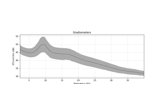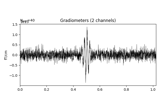mne.time_frequency.tfr_stockwell¶
- mne.time_frequency.tfr_stockwell(inst, fmin=None, fmax=None, n_fft=None, width=1.0, decim=1, return_itc=False, n_jobs=1, verbose=None)[source]¶
Compute Time-Frequency Representation (TFR) using Stockwell Transform.
Same computation as
tfr_array_stockwell, but operates onEpochsobjects instead ofNumPy arrays.See 1234 for more information.
- Parameters
- inst
Epochs|Evoked The epochs or evoked object.
- fmin
None,float The minimum frequency to include. If None defaults to the minimum fft frequency greater than zero.
- fmax
None,float The maximum frequency to include. If None defaults to the maximum fft.
- n_fft
int|None The length of the windows used for FFT. If None, it defaults to the next power of 2 larger than the signal length.
- width
float The width of the Gaussian window. If < 1, increased temporal resolution, if > 1, increased frequency resolution. Defaults to 1. (classical S-Transform).
- decim
int The decimation factor on the time axis. To reduce memory usage.
- return_itcbool
Return intertrial coherence (ITC) as well as averaged power.
- n_jobs
int The number of jobs to run in parallel (over channels).
- verbosebool,
str,int, orNone If not None, override default verbose level (see
mne.verbose()and Logging documentation for more). If used, it should be passed as a keyword-argument only.
- inst
- Returns
- power
AverageTFR The averaged power.
- itc
AverageTFR The intertrial coherence. Only returned if return_itc is True.
- power
See also
Notes
New in version 0.9.0.
References
- 1
R. G. Stockwell. Why use the S-transform? In Luigi Rodino, Bert-Wolfgang Schulze, and M. W. Wong, editors, Pseudo-Differential Operators: Partial Differential Equations and Time-Frequency Analysis, number 52 in Fields Institute Communications, pages 279–309. American Mathematical Society, Providence, RI, 2007. doi:10.1090/fic/052.
- 2
Ali Moukadem, Zied Bouguila, Djaffar Ould Abdeslam, and Alain Dieterlen. Stockwell transform optimization applied on the detection of split in heart sounds. In Proceedings of EUSIPCO-2014, 2015–2019. Lisbon, 2014. IEEE. URL: https://ieeexplore.ieee.org/document/6952743.
- 3
Katherine L. Wheat, Piers L. Cornelissen, Stephen J. Frost, and Peter C. Hansen. During visual word recognition, phonology is accessed within 100 ms and may be mediated by a speech production code: evidence from magnetoencephalography. Journal of Neuroscience, 30(15):5229–5233, 2010. doi:10.1523/JNEUROSCI.4448-09.2010.
- 4
Kevin A. Jones, Bernice Porjesz, David Chorlian, Madhavi Rangaswamy, Chella Kamarajan, Ajayan Padmanabhapillai, Arthur Stimus, and Henri Begleiter. S-transform time-frequency analysis of P300 reveals deficits in individuals diagnosed with alcoholism. Clinical Neurophysiology, 117(10):2128–2143, 2006. doi:10.1016/j.clinph.2006.02.028.

